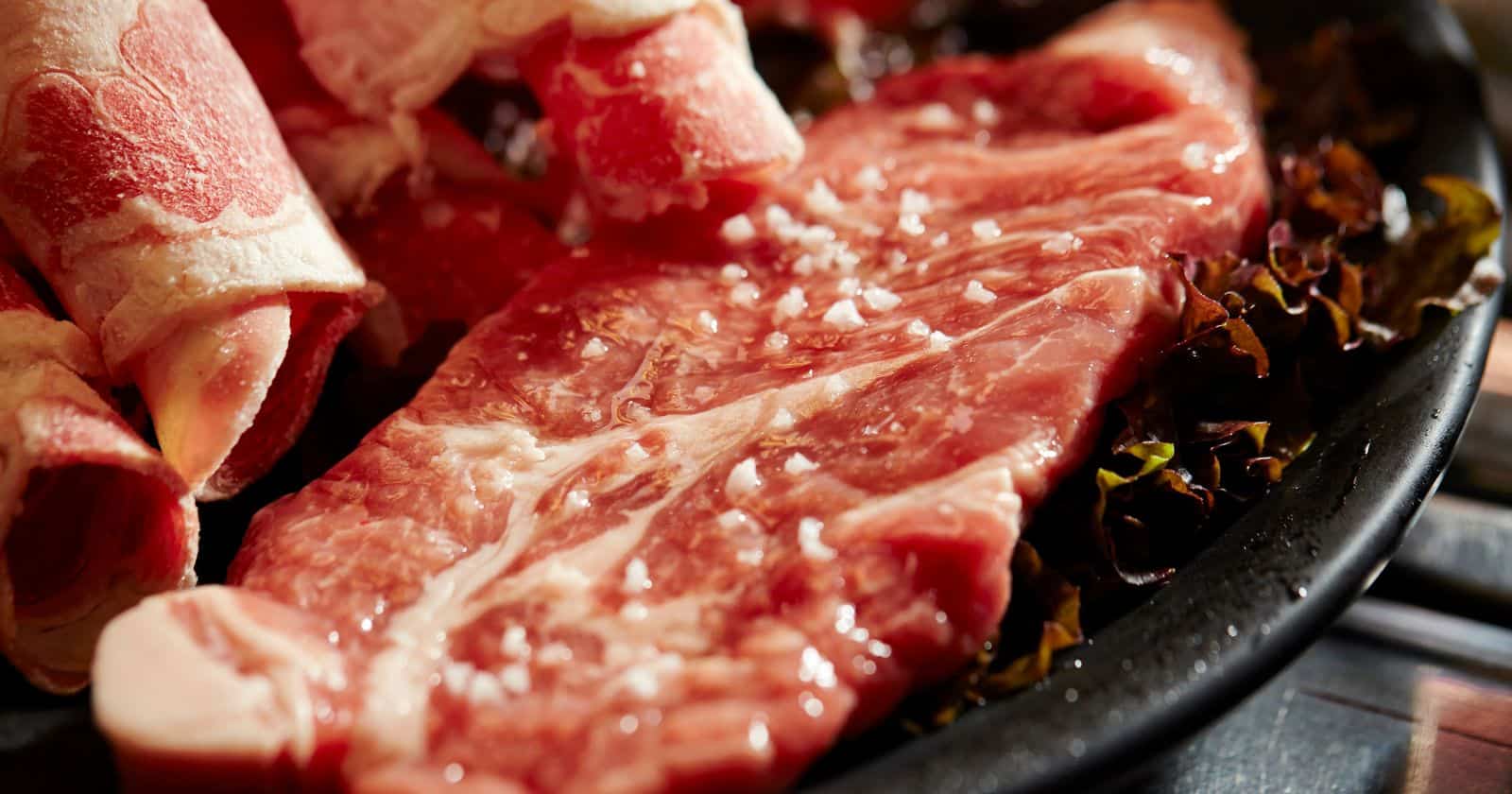Are you craving the bold flavors of Korean BBQ but don’t have a grill? Don’t worry! You can still satisfy your cravings by cooking Korean BBQ at home using a simple cast-iron pan or nonstick pan on your stovetop. No grill? No problem!
In this blog post, we’ll walk you through the steps of cooking Korean BBQ without a grill, from choosing the perfect meat to marinating it in a delicious Korean BBQ sauce.
We’ll also guide you on how to cook the meat to perfection and serve it with a delectable array of banchan, or side dishes.
Choosing the Right Meat or Vegetables
When it comes to Korean BBQ, selecting the right meat and vegetables is essential for a delicious and authentic dining experience. Here are some tips to help guide your choices:
Vegetables:
- Opt for vegetables that can add texture and enhance the flavors of the meats.
- Popular vegetable options for Korean BBQ include lettuce, perilla leaves, mushrooms, onions, squash, zucchini, and eggplant.
- You can also grill other vegetables like bell peppers, carrots, and asparagus to add variety to your BBQ spread.
Meat:
- While beef and pork are the most common proteins used in Korean BBQ, chicken can be a great alternative if you’re not a fan of beef and pork.
- Popular cuts of meat for Korean BBQ include bulgogi (thinly sliced marinated beef), galbi (beef short ribs), and samgyeopsal (pork belly).
- If you’re a vegetarian, consider grilling vegetables and tofu instead of meat and indulge in the various vegetarian side dishes called banchan.
Banchan:
- Banchan, the small side dishes served with Korean BBQ, can elevate the overall dining experience.
- These side dishes often include pickled vegetables, seasoned greens, and marinated tofu.
- Some Korean BBQ restaurants even offer vegan and vegetarian options like vegan bibimbap, alongside plenty of vegetables and rice.
In addition to these tips, don’t forget about the sauces. Korean BBQ is typically served with a variety of flavorful sauces like ssamjang (spicy soybean paste), gochujang (spicy red pepper paste), and sesame oil with salt and pepper. These sauces add depth and enhance the taste of the meat and vegetables.
Marinating the Meat or Vegetables: Enhancing the Taste
Marinating the meat or vegetables is a crucial step in enhancing the taste of Korean BBQ. To marinate your meat or vegetables to perfection, here are some tips to follow:
Choose the Right Marinade: Select a marinade that complements the specific meat or vegetables you’re using. Popular ingredients in Korean BBQ marinades include soy sauce, sesame oil, garlic, ginger, and brown sugar. These ingredients add depth of flavor and a touch of sweetness.
Marinate for the Right Amount of Time: Allow your meat or vegetables to marinate for at least 30 minutes to ensure the flavors penetrate and enhance the taste. For a more intense flavor infusion, marinate overnight. The longer you marinate, the more flavorful the end result will be.
Use a Ziplock Bag: Place the meat or vegetables in a ziplock bag with the marinade. This guarantees that the marinade coats the ingredients evenly. It also makes it more convenient for storing and transporting.
Remember to discard any leftover marinade that has come into contact with raw meat to avoid cross-contamination. However, you can reserve a portion of the marinade for basting or dipping purposes.
Furthermore, don’t be afraid to experiment with different flavors and ingredients to find your preferred taste. Consider adding gochujang (Korean chili paste), pear juice, or rice wine vinegar to your marinade for a unique twist. These additions can elevate the flavors and create a more authentic Korean BBQ experience.
Preparing the Pan: Essential Tips for Cooking
When it comes to cooking Korean BBQ without a grill, preparing the pan properly is crucial. Here are some essential tips to ensure a successful cooking experience:
Use a Cast-Iron or Nonstick Pan: To achieve the best results, opt for a cast-iron or nonstick pan. These types of pans distribute heat evenly and prevent the meat from sticking, ensuring a delicious outcome.
Add Oil: Brushing some oil on the pan or rubbing the fattiest meat on the surface can make a significant difference. Not only does this prevent the meat from sticking, but it also adds flavor to your Korean BBQ.
Cook in Batches: Avoid overcrowding the pan with too much meat or vegetables at once. Cooking in batches ensures that each piece gets cooked evenly and has enough space to caramelize, resulting in delicious flavors.
Cut Meat into Bite-Size Pieces: Before cooking, cut the meat into bite-size pieces using scissors. By doing so, you make it easier to cook and eat, enhancing the overall experience.
Additional Tips:
- Use a Splatter Screen: Korean BBQ can produce a lot of smoke and splatter. To keep your stovetop clean and prevent oil and juices from splattering, use a splatter screen.
- Cook Vegetables First: If you’re cooking both meat and vegetables, start by cooking the vegetables before adding the meat. This prevents the meat juices from overcooking the vegetables and ensures they retain their freshness and texture.
Cooking Korean BBQ in a Cast-Iron or Nonstick Pan
To cook Korean BBQ in a cast-iron or nonstick pan, follow these essential tips:
Preheat the pan: Before adding the marinated meat or vegetables, heat up your cast-iron or nonstick pan over medium-high heat. This will ensure even cooking and help to achieve that delicious caramelization.
Add oil: To prevent sticking and enhance flavor, brush some oil on the pan or rub the fattiest meat on the pan. This step is crucial in creating that beautiful char and preventing the BBQ from clinging to the surface.
Cook in batches: Avoid overcrowding the pan with too much meat or veggies at once. Cooking in batches ensures that each piece has enough space to caramelize and cook evenly. It also prevents the ingredients from releasing excess moisture, resulting in a more flavorful BBQ.
Cut meat into bite-size pieces: For easier cooking and eating, use scissors to cut the meat into bite-size pieces. This allows for faster cooking times and ensures that the meat is tender and easy to handle.
Cook vegetables first: If you’re preparing both meat and vegetables, cook the veggies first before adding the meat. By doing this, you prevent the meat juices from overcooking the vegetables and ensure that each element retains its distinct flavor.
Use a splatter screen: Korean BBQ can produce a lot of smoke and splatter. To avoid oil and juices splattering all over your stovetop, use a splatter screen. This handy tool will help keep your cooking area clean and safe.
Achieving Perfectly Cooked Meat or Vegetables: Timing and Temperature
To achieve perfectly cooked meat or vegetables when cooking Korean BBQ in a cast-iron or nonstick pan, timing and temperature are key factors to consider. By following the tips below, you can ensure delicious and safe results:
Use a food thermometer: Utilize a food thermometer to check the internal temperature of the meat or vegetables. The safe internal temperature for most meats is 145°F (63°C) for whole meats and 160-165°F (71-74°C) for ground meats. Vegetables should be cooked to an internal temperature of at least 165°F (74°C).
Cook meat to the right temperature: Cooking the meat to the correct temperature is crucial to achieve both safety and texture. Overcooking can result in dry and tough meat, while undercooking can lead to foodborne illnesses.
Adjust cooking time: Take into account the thickness of the meat or vegetables and adjust the cooking time accordingly. Thicker cuts of meat will require more time to cook compared to thinner cuts.
Rest the meat: After cooking, allow the meat to rest for a few minutes. This allows the juices to redistribute and the meat to become more tender and flavorful.
Vegetarian-Friendly Options: Grilling Vegetables and Tofu
Grilling vegetables and tofu is a fantastic option for those looking for vegetarian-friendly choices for Korean BBQ. Not only is it delicious, but it also offers a healthy alternative to traditional meat-based options. Here are some tips and recipes to help you get started on your grilling journey.
Choose the Right Vegetables:
- Bell peppers, zucchini, eggplant, mushrooms, onions, and asparagus are excellent choices for grilling.
- Cut the vegetables into bite-size pieces or slices for easy grilling.
Use a Marinade:
- Marinating the vegetables can add depth and complexity to the dish.
- Consider using ingredients like soy sauce, sesame oil, garlic, ginger, and brown sugar for a flavorful marinade.
Grill the Vegetables:
- Preheat your grill or grill pan to medium-high heat.
- Brush the vegetables with oil and place them on the grill.
- Cook until they are tender and have grill marks, remembering to flip them occasionally.
Choose the Right Tofu:
- Opt for extra-firm tofu, as it can stand up to the grill and retain its texture.
- Before grilling, press the tofu to remove excess water.
Use a Marinade:
- Marinating the tofu can enhance its flavor and add depth to the dish.
- Consider using ingredients like soy sauce, sesame oil, garlic, ginger, and brown sugar for a tasty marinade.
Grill the Tofu:
- Preheat your grill or grill pan to medium-high heat.
- Brush the tofu with oil and place it on the grill.
- Cook until it is golden brown and has grill marks, flipping it occasionally.





